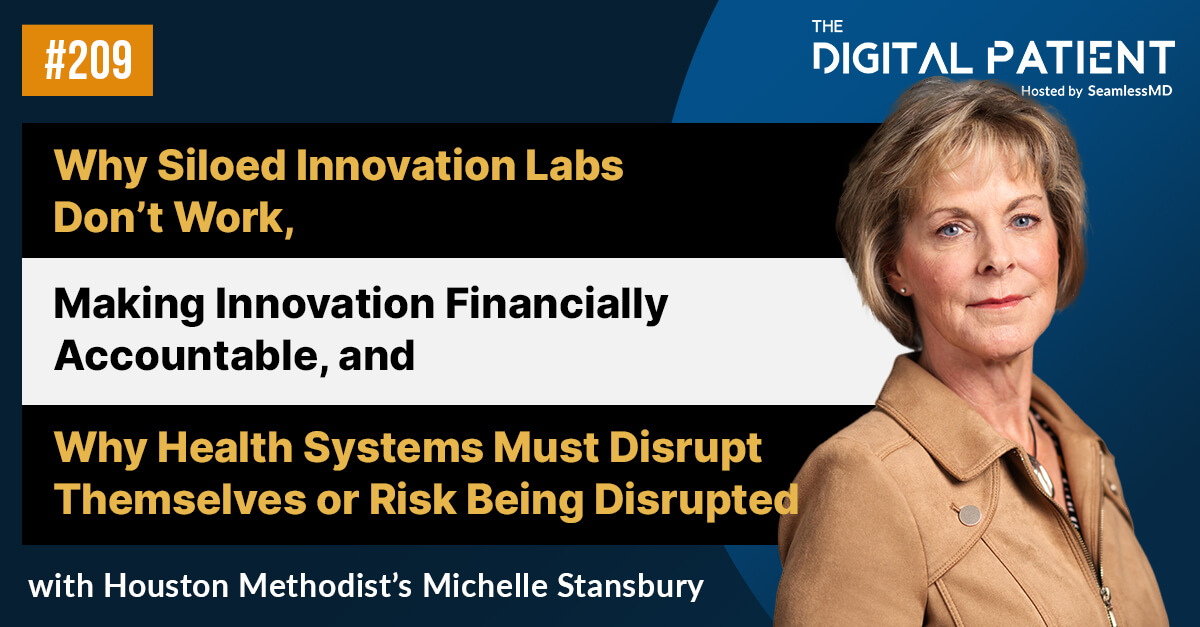Subscribe on: RSS | SPOTIFY | APPLE PODCAST | GOOGLE | BREAKER | ANCHOR
Video:
In this episode of the SeamlessMD Podcast, Dr. Joshua Liu, Co-founder & CEO at SeamlessMD, and marketing colleague, Alan Sardana, discuss Using Digital Patient Engagement For Patient-Reported Outcomes (PROs) including the power of machine learning applied to granular PROs for real-time patient outcome predictions. See the full show notes below for details.
Guest(s): Dr. Joshua Liu (@joshuapliu), Co-founder & CEO at SeamlessMD
Episode 12 – Show notes:
[00:00] Alan’s pickleball story;
[02:20] How healthcare historically has been good at tracking clinical outcomes such as Length of stay, complication rates, readmission rates, mortality rates, infection rates, etc. and how we’ve shifted (in the last few decades) to be more patient-centered and consumer-centric by collecting Patient-reported Outcomes (P.R.O.s);
[04:20] Why Patient-reported Outcomes are valuable to collect to better understand what is important for patients and as a measure for how well we deliver healthcare;
[05:00] How payers are slowly introducing incentive models requiring validated P.R.O. survey collection such as HOOS and KOOS surveys for Total Joint Replacement;
[05:40] How insights from validated P.R.O. surveys (e.g. HOOS, KOOS, VR-12, PROMIS-10, EQ-5D, etc.) are limited by the time points collected (e.g. cadence might be a few weeks pre-op, 30-days post-op, 3 months post-op, 6 months post-op, 12 months post-op) and how traditional P.R.O. data collection effort like calling patients is not feasible for daily collection;
[08:10] Why Patient-reported Outcome response rates are so low historically due to patients not seeing value for their responses and how digital solutions automate P.R.O. data collection and enable patients to report outcomes remotely;
[11:20] How Digital Patient Engagement drives response rates to P.R.O. surveys because it provides value to patients throughout their journey (e.g. protocol reminders, education, progress tracking, feedback etc.);
[12:35] How SeamlessMD collects more Patient-reported Outcomes than other methods and how it provides immediate, personalized feedback to the patient based on their reporting;
[14:20] How SeamlessMD collects more granular P.R.O.s with daily symptom reporting, how healthcare providers can use SeamlessMD to map out the actual patient recovery journey such as post-op day 1-30 pain, and how the data can be segmented to quickly see how trends change between ages, demographics, comorbidities, different implants etc.;
[16:20] How Digital Patient Engagement enables the healthcare provider to collect additional P.R.O.s beyond functional status such as patient compliance, opioid consumption etc.;
[18:20] Why (in the not-so-distant future) insurers may reimburse based on P.R.O.s and patient compliance;
[18:50] How P.R.O.s collected via Digital Patient Engagement can determine the impact of specific patient protocols on patient-reported and clinical outcomes;
[19:10] How Rush University used SeamlessMD to determine the compliance and impact of a particular ERAS protocol on SSIs (as commonly purported), found it had no correlation, and ultimately removed the protocol from their ERAS care pathway;
[20:30] How healthcare providers using Digital Patient Engagement can use the data to change practice such as by introducing a new pain regimen, measuring compliance, and correlating changes with daily patient-reported pain trends;
[21:20] How Digital Patient Engagement assists research efforts and accelerates quality improvement by automatically collecting Patient-reported Outcomes in the background;
[23:10] How same-specialty clinical partners using SeamlessMD across North America have formed multi-site P.R.O. Quality Collaboratives to benchmark Patient-reported Outcomes, share best practices and protocols, and conduct multi-site research;
[23:35] How Baystate Health, UAB Medicine, Montreal Heart and other leading cardiac centers use SeamlessMD to benchmark more Patient-reported Outcomes than the national registries (e.g. with granular P.R.O.s such as post-op day 1, 2, 3, etc. pain scores, opioid consumption, compliance) and how SeamlessMD creates unique opportunities for research and quality improvement via collaboration;
[27:50] How clinical outcomes such as complication rates and readmission rates are “lagging indicators” and how SeamlessMD allows the healthcare team to benchmark “early indicators” such as mobilization as it impacts length of stay or carb-loading compliance for length of stay and complications, etc.;
[29:40] Why Digital Patient Engagement makes care truly patient-centered by collecting the patient voice and providing personalized feedback based on patient input;
[30:10] How machine learning can be applied to Patient-Reported Outcomes for better predictive analytics and how SeamlessMD is combining historical patient data with granular P.R.O.s captured on the platform to inform the healthcare team of potential risk in real-time (e.g. Patient X on post-op day 7 has reported a, b, and c, which indicates they have a 40% chance of being readmitted in the next 3 days – you should reach out to this patient today);
[32:50] How, historically, Patient-Reported Outcomes have been used to learn “what happened” to the patient, and how SeamlessMD is using granular P.R.O.s to drive more advanced monitoring in real-time to predict “what will happen” to the patient;
.svg)









.png)
